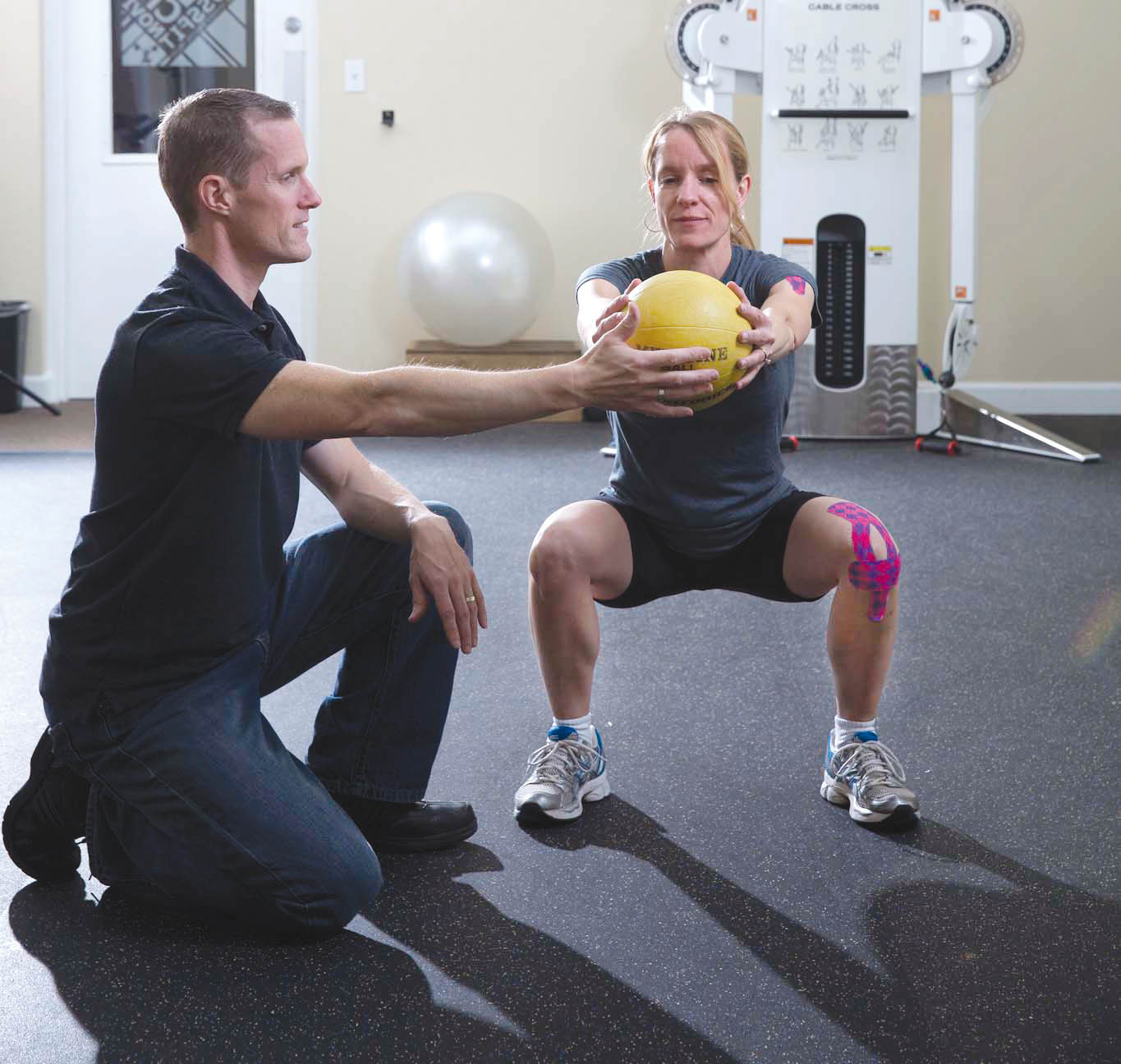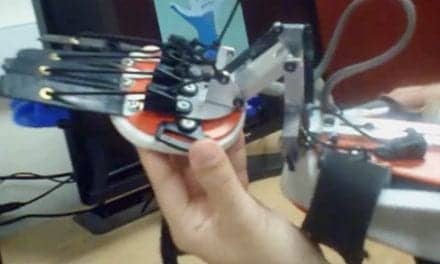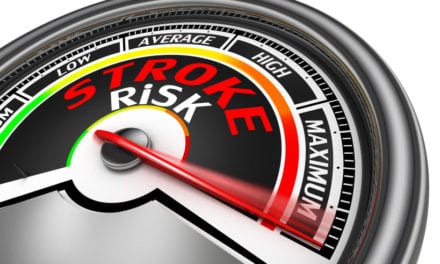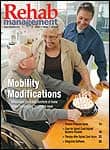A vital portion of an endurance athlete’s treatment hinges on education and prevention. There should be a focus on functional strength training and full weight bearing, closed kinetic chain activities performed with medicine balls or kettle bells, in addition to free weights. (Image courtesy Martin Vecchio)
by Brian J. Adams, PT, DPT, OCS, CSCS
Over the past decade, the American public has seen a general surge in physical activity. Some people are driven by the goal of better health or weight loss. Others are drawn to the thrill of competition or a basic love of activity. There has been an increased participation level in endurance sports: running, cycling, triathlon, and similar sports. The advent of nontraditional adventure/running races has accelerated the level of endurance event participation. This has begun to highlight the fact that the weekend warrior is beginning to make up a large share of the competitive athletic landscape. With the increased supply of endurance athletes, physical therapists and sports medicine clinicians need to be prepared to efficiently and effectively handle these cases.
Sports participation comes with a calculated level of injury risk. For the purposes of this article, these injuries fall into two main categories: 1) repetitive/overuse injuries; and 2) acute/traumatic injuries. The focus here is on overuse injuries commonly seen among endurance athletes, along with the biomechanics and physiology behind the tissue breakdowns. Additionally, we identify common tools and treatments deployed by sports medicine clinicians to get these athletes back into the game.
ANATOMY OF AN OVERUSE INJURY
The human body is very capable of adapting to stress applied to it. Wolfe’s law (bone) and Davis’ law (soft tissue) describe such protective repair phenomena. For athletes in training, sport-specific training is an ideal course of stress for the body. Runners will run, cyclists will ride, and swimmers will swim…a lot! But all too often, overuse injuries have a key defining factor: the amount of stress (or load) placed on the tissue over time causes tissue breakdown that exceeds the repair capabilities of the body. There is a major contribution of biomechanical and technique flaws, which increase loads on specific tissues, accelerating the breakdown process. Ultimately, this will result in chronic inflammation, micro-tearing, scarring, and pain in the tissues that can derail an athlete’s season.
The very premise of sport-specific training and progressive loading is to stimulate the growth of the athlete’s tissues. Concurrently, the role of a training/coaching program is to plan the appropriate stress and recovery patterns to optimize the athlete’s gains, reduce the risk for overuse injury, and allow the athlete to peak for optimum performance.
COMMON UPPER EXTREMITY INJURIES
Overhead athletes utilize their upper extremities with highly repetitive and forceful movements. Sports such as volleyball, tennis, and baseball place a large volume of forces through the glenohumeral joint while it is in a relatively unstable, overhead position. These activities have been well documented, and these same mechanisms of injury can be seen among endurance athletes.
Swimmers are especially prone to repetitive stress of their shoulders and arms. Technique plays a significant role in the efficiency of swimming, and small flaws will quickly sideline the most ambitious athlete. Triathletes are known to skip over swimming and technique-specific drills, focusing on the running and cycling portions of their training. Specific to these athletes, chronic irritation and micro-tearing of the rotator cuff can lead to pain and dysfunction. During overhead movement such as reaching during swimming, the coracoacromial arch narrows on the adjacent bursa and tendons. This creates a potential environment of chronic irritation, and leaves the tissue prone to long-term inflammation. Scapular muscle imbalance and thoracic hypomobility also can contribute to significant technique faults. Coaching and precise stroke analysis are necessary to keep these athletes healthy and injury-free. Special attention should be placed on rehabilitation of the rotator cuff and scapular muscles throughout the range of motion for the shoulder, along with thoracic spine mobility.
When endurance athletes work on power and strength in the gym, they commonly suffer repetitive micro-traumas to the shoulder and elbow. The overuse from their current sport, combined with potential overload with strength training, can commonly result in rotator cuff tendinitis and lateral epicondylitis. The long-term solution is often rest, activity modification, and conservative treatment with physical therapy. Programs that include sport-specific strength training should consider dosing of activity combined with expert-level coaching on technique.
COMMON LOWER EXTREMITY INJURIES
The recent surge in running, adventure races, cycling, and triathlon participation has created an increased number of injuries, commonly in the foot and knee due to the repetitive loads placed on these structures. These athletes often complain of anterior and lateral knee pain. While some will develop issues in the posterior knee and around the medial joint line, the patellar tendon and the iliotibial band tend to create the greatest frequency of complaints.
Often knee pain can be traced back to a biomechanical fault, technique flaw, or muscle imbalance. The location of the pain is typically not the source of the dysfunction, so the need for the clinician to dig deep into the evaluation process is paramount to achieve an effective outcome. Hip weakness or loss of flexibility, combined with loss of proprioception, can greatly alter the mechanics of the athlete. It should be considered that when there is knee pain, a deeper evaluation of the foot/ankle and hip/lumbo-pelvic region is warranted.
Foot and ankle pain while running can often be attributed to plantar fasciitis and Achilles tendinitis. Foot neuromas, toe traumas, and stress fractures are also common. As with most overuse injuries, these can be traced back to a technique or biomechanical fault. Special consideration should be placed on shoe wear and the potential need for an orthotic device when warranted.
Although cycling is considered a low-stress, nonimpact environment, the opportunity for repetitive stress is high. Simple math illustrates that an average cyclist riding for 1 hour, averaging 95 revolutions per minute, will pedal more than 5,700 times per leg in the course of 1 hour. As volume increases, any small biomechanical fault will quickly be exploited. For example, a saddle that is too low for the cyclist can create excessive knee flexion angles, resulting in compressive and shear forces on the patellofemoral joint of the knee. A saddle that is too high will force the cyclist to overreach during the pedal stroke, which can place undue tension on the posterior leg (hamstrings and calf/Achilles) or the lumbar spine.
AN OUNCE OF PREVENTION
A key portion of an endurance athlete’s treatment should revolve around education and prevention. Once the clinician has addressed the pain, biomechanics, and tissue dysfunction, attention needs to be turned to a thorough evaluation of their Annualized Training Program. This includes analysis of their training on a season-long view, with focus on periodization of training. Both are key pieces in the puzzle of endurance training and injury prevention.
Bike fitting on a professional level takes on many shapes and sizes. For the clinician, the ability to analyze a cyclist on their bike is paramount to establishing an optimized fit to minimize excess tissue stress while maximizing power output and efficiency. With advanced training in anatomy and biomechanics, physical therapists are ideally poised to address these issues seen in cycling. Consideration of the foot-shoe-cleat interface is a starting point for the bike fit process. Some companies offer education, tools, and supplies to help the clinician address issues with foot position to optimize alignment and power production on the bike.
Running gait analysis is a key ingredient to identify biomechanics of the athlete and optimize their choices in stride, cadence, foot strike, and shoe wear. The runner’s strength and size, foot type, mobility/flexibility, event focus, terrain, and training volume all play a role in these choices. A discussion with the runner about their running style and training program is a good starting point. As with bike fitting, special consideration must be placed on the mechanics along with clearing any movement dysfunctions identified in the clinical assessment.
INTERVENTIONS AND OTHER EQUIPMENT
The utilization of specific equipment will vary depending on the clinic and the athlete’s need. To properly analyze the biomechanics of an athlete, it is imperative to assess the athlete in their element. For cyclists, observation on their bike requires a trainer, which clamps onto the back of the bike. A runner is most effectively evaluated at running speed on a treadmill, preferably one that has a long deck and a strong enough motor to run steadily at speed.
When considering sport-specific evaluation of these athletes, video capture is ideal. A high-speed camera (more than 60 frames per second) combined with video software will allow the clinician and athlete to review the biomechanics and specifically address the faults. Custom foot orthotics in running and cycling are often found to be useful when faulty biomechanics are a contributing factor to the soft tissue damage. A runner with a hypermobile or flat longitudinal arch could benefit from an orthotic that assists in the support and deceleration, or “slowing down,” of the pronation movement within the foot. A cyclist with subtle forefoot varus can feel effects into their knee and hip.
Care should be taken with the selection of the orthotic, as length, height, rigidity, and materials can all affect the runner’s comfort level. For the cyclist, special attention should be placed on the forefoot as the primary contact and load are through the metatarsal heads and the “ball of the foot.” For some basic biomechanical corrections, often the simple solution of an off-the-shelf orthotic is an easy, cost-effective option.
Due to the non-weight-bearing position of cyclists, there is a risk of demineralization of healthy bones. It is common for a cyclist to sustain fractures during a crash at high speed. The typical mechanism of injury is a fall on an outstretched hand, often resulting in a fractured clavicle or wrist. Initiating a course of full-body strength training during the off-season, combined with plyometrics, is an imperative step in protecting the bone health of the cyclist while preventing potential traumatic fractures in the future.
Focus on functional strength training and full weight-bearing, closed kinetic chain activities also will develop the movement patterns often utilized in the endurance athlete. Using a cable crossover device to offer lower and upper extremity resistance “drivers” can help these patients develop core stability and functional movements that will translate to safer, more efficient power production on the bike or during a run. Functional exercises can also be performed with medicine balls or kettle bells, in addition to free weights. To further streamline safe and efficient movement, athletes are often instructed on sport-specific movements resisted by therapy bands, which offer versatility and the ability to mimic almost any sport motion. Swimmers struggle with rotator cuff and scapular-thoracic dysfunction, and runners often have weak hip rotators and stabilizers. These weaknesses can be isolated and addressed with specific training in a controlled setting. Basic shoulder and hip stability exercises can easily be progressed to dynamic proprioceptive neuromuscular facilitation exercises while using the same resistance band.
CONCLUSIONS
Due to the high-volume, repetitive nature of their sports, endurance athletes are prone to overuse injuries. The clinician should be an advocate and mentor for these individuals. A high level of importance should be placed on understanding the athlete and the sport in which that person participates. A full clinical evaluation, along with a biomechanical assessment within the sport/discipline, is paramount to developing an effective treatment plan for these patients. A solid review of their annual training plan is equally important. Particular attention should be placed on bike fitting for the cyclist and running gait analysis for the runner.
There are many products, tools, and techniques available to clinicians to better evaluate these endurance athletes. These can be utilized to drive home the educational aspect of care and assist in injury prevention. Ultimately, after identifying and correcting biomechanical faults, the athlete must allow time for soft tissue repair and adaptation. Underlying health concerns, strength discrepancies, and movement dysfunctions may require a long-term focus. Only then can the responsibility be placed back on the athlete to resume their training plan. RM
Brian J. Adams, PT, DPT, OCS, CSCS, is a practicing physical therapist and owner at Adams Sports Medicine & Physical Therapy, P.C., Novi, Mich. He is an Orthopaedic Clinical Specialist and Certified Strength and Conditioning Specialist. He is a Certified BikeFit Pro/Instructor, USA Cycling Coach, and Elite level cyclist, focusing on the needs of the cyclist/triathlete. He routinely makes presentations directed at evaluation and treatment of the upper and lower extremities as they relate to endurance athletes. For more information, contact [email protected].
REFERENCES/RECOMMENDED READING
NSGA Sports Participation in the United States, 2014 Edition. e-mail: [email protected], phone: (847) 296-6742, or visit: www.nsga.org
MacLean CL, van Emmerik RE, Hamill J. Influence of custom foot orthotic intervention on lower extremity intralimb coupling during a 30-minute run. J Appl Biomech. 2010;26(4):390-9.
Saragiotto BT, Yamato TP, Lopes AD. What do recreational runners think about risk factors for running injuries? A descriptive study of their beliefs and opinions. J Orthop Sports Phys Ther. 2014;44(10):733-8.
Sherk VD, Barry DW, Villalon KL, Hansen KC, Wolfe P, Kohrt WM. Bone loss over 1 year of training and competition in female cyclists. Clin J Sport Med. 2014;24(4):331-6.
Walker H, Gabbe B, Wajswelner H, Blanch P, Bennell K. Shoulder pain in swimmers: a 12-month prospective cohort study of incidence and risk factors. Phys Ther Sport. 2012;13(4):243-9.
Tate A, Turner GN, Knab SE, Jorgensen C, Strittmatter A, Michener LA. Risk factors associated with shoulder pain and disability across the lifespan of competitive swimmers. J Athl Train. 2012;47(2):149-58. doi: 10.1097/JSA.0b013e318261ec58.
Bales J, Bales K. Training on a knife’s edge: how to balance triathlon training to prevent overuse injuries. Sports Med Arthrosc. 2012;20(4):214-6.
Ristolainen L, Kettunen JA, Waller B, Heinonen A, Kujala UM. Training-related risk factors in the etiology of overuse injuries in endurance sports. J Sports Med Phys Fitness. 2014;54(1):78-87.






